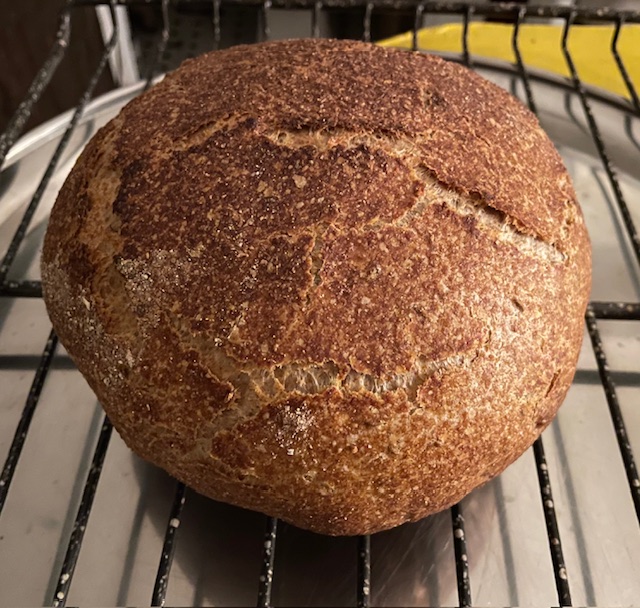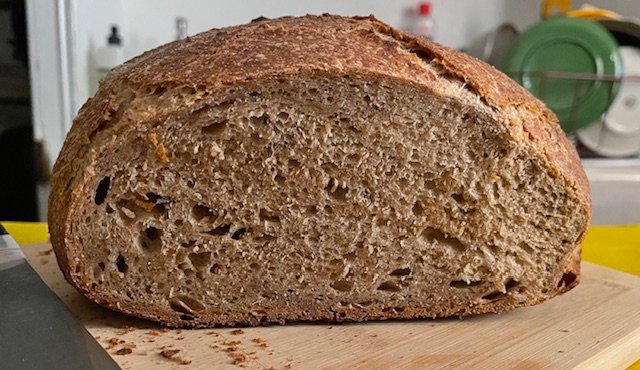squattercity
Mon, 03/31/2025 – 07:17
45% complete rye/55% bread flour (all of the rye prefermented with a 3% inoculation for 12 hours) … 1% caraway … 1% salt … whole hydration ~80%


tastes nice … however in my quest for a extra expansive crumb, I am considering that subsequent time I would substitute the bread flour with all-purpose … and presumably add a pale rye malt scald.
Rob
Sail upon the seven seas of rye! Love the pale color, and that crumb appears excellent to me for some form of deli meat and mustard.
-Jon
although I am excited by your quest for a extra expansive crumb, Rob. Would AP assist with that? And the way would the scald assist with that too? And by expansive, are we trying actually for one thing that expands extra, i.e. extra holes, extra rise, extra spring? Or is it additionally the feel of the crumb you are focusing on, i.e. a extra tender crumb? The tenderness I’ve positively gotten with AP; the holes I’ve extra luck with bread flour (for similar day bakes, and with hand mixing).
thx, Lin, on your ideas. The bread is scrumptious & the crumb is loads tender & moist. However it is a bit dense/heavy. Earlier than my issues with my rye flour (finer grind yielding over-fermented levains, which I efficiently combatted with a diminished inoculation), my loaves got here out gentle & ethereal. This one rose fantastically however nonetheless felt heavy once I pulled it from the oven.
Perhaps I am overthinking it. Perhaps the issue is the finer grind of the rye and I’ve to dial the rye %age again.
However after studying this from Maurizio Leo — https://www.theperfectloaf.com/sourdough-bread-high-protein-white-bread-flour/ — my thought is that possibly the bread flour could possibly be weighing it down.
Rob
Did the dough utilizing the finer grind behave otherwise throughout bulk fermentation and proof? I am questioning if the grind adjustments its capacity to soak up water, for instance, which might have an effect on fermentation, baking period and many others. I additionally marvel if simply pushing BF and proof additional could possibly be value attempting first – at the least that is what I’ll do first – and if that does not change issues, at the least we will strive different issues.
With 55% bread flour and hand mixing, maybe extra gluten improvement may additionally assist. As a hand mixer myself, I discover that giving the dough quite a lot of time for BF to construct power, with some SFs, or good upfront mechanical kneading of the dough is important when utilizing quantity of bread flour within the dough. The shorter the BF and fewer folds I can handle, the extra I knead upfront. So possibly the grind has affected BF period and therefore….?
All simply guesses after all.
nice factors, Lin. Concentrating extra on creating the dough could be the important thing … thanks!
My rye flour positively handles otherwise. I sense that it is thirstier and tougher to get absolutely hydrated. I used to do 10 or 15% inoculation and the levain would fire up straightforward and unfold within the bowl (I consider this as ‘reclining’ — like being tilted again in a la-z-boy lounge chair with the built-in footrest up) with out overfermenting once I left it for 16 or 18 hours. At 3% inoculation, the rye pre-ferment was nonetheless taut after 12 hours — not relaxed and even visibly bubbly.
Curiously, the completed loaf additionally appears darker than it was once. (see https://www.thefreshloaf.com/node/73244/45-rye for certainly one of my bakes with the coarser rye flour.)
I hand kneaded this one moderately vigorously for possibly 12 minutes. However I in all probability used to do at the least 15. I additionally did 2 folds throughout a 2 hour bulk — however I used to do 3. Proof is about an hour. I have been eager to maintain the majority and proof brief as a result of I do not need the dough to overferment and repeat all these bakes the place my loaves unfold with out rising. Additionally, I like the thought of beginning the levain at 7 within the morning, returning at, say, 7 or 8 within the night, and having the bread out of the oven & cooling on the counter (if I can resist slicing into it) earlier than midnight.
Rob
I carry on questioning about your rye flour, do you have a tendency to stay to the identical model? I am additionally considering of that interview with the modernist bakers the place they realised that American rye flour was not so good as the European one.
-Jon
the model I exploit (farmer floor flour, which is a neighborhood NY collaboration between farmers & a miller) is the most effective complete rye I can get within the small portions I want 👉🏼(tho having written that, your query jogs my memory that I may strive some Euro complete rye from a fairly native Polish grocery)👈🏻
👍🏼
Rob
PS — I like modernist fiction … however I do not find out about modernist baking🤔
That is what they needed to say about rye:
https://modernistcuisine.com/mb/the-difference-between-american-rye-and-european-rye/
The taut unbubbly levain may additionally be an indication that it may in all probability go additional, what do you assume, Rob? Perhaps one thing within the flour has modified but once more. I ponder if a much less energetic levain than traditional may finally be on the root of all this. Maybe if the levain could possibly be used when it is at a bubblier stage, then the standard BF, proof and gluten improvement processes/period may stay the identical. If I have been to maintain the identical 12-hour body for the levain, I would nicely enhance the inoculation a slight bit and go from there. In spite of everything, a levain that has gone previous its peak for an hour or two inside this time window would nonetheless be superb to make use of.
The comparability along with your loaf of 2023 is sort of stark each when it comes to crumb and crust color. But in addition when it comes to rise and spring. They definitely behave like two fully totally different flours! This jogs my memory of one thing actually humorous that occurred to a buddy not too long ago. We purchase the identical 10kg bread flour luggage from the identical mill, and he was having difficulties along with his loaves for a number of months – all the things would go nicely till the loaf was loaded into the oven, the place it might fairly merely collapse. Once I seemed on the crumb shot of the 100% bread flour loaf, I remarked that he will need to have used a unique flour by mistake – the crumb was so darkish, basically brown. I had by no means gotten that color, ever, from the identical flour! I informed him one thing should be actually fallacious with that flour. Seems we’ve been utilizing the identical flour, however his bag had already gone barely rancid, a pair months previous its expiry date! His loaves recovered the second he purchased a brand new bag.
All this to say – crumb color can generally additionally point out fermentation points that in flip would possibly reveal extra concerning the state of the flour.

